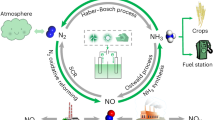Abstract
IN carrying out research in these laboratories on the corrosion of tin in anaerobic fruit acids, information was required on the thickness of the natural oxide film on tin. Since there appeared to be no published information about the thickness of tin oxide films, it was necessary to measure it, and for this purpose electrometric reduction has been found suitable. This method1,2 is generally considered to be applicable only to metals more electronegative than hydrogen ; but it succeeds for tin because of its high hydrogen overpotential. At room temperature the oxide film on tin probably consists of stannous oxide3,4, and we have calculated our results on this basis.
This is a preview of subscription content, access via your institution
Access options
Subscribe to this journal
Receive 51 print issues and online access
$199.00 per year
only $3.90 per issue
Buy this article
- Purchase on Springer Link
- Instant access to full article PDF
Prices may be subject to local taxes which are calculated during checkout
Similar content being viewed by others
References
Evans, U. R., “Metallic Corrosion, Passivity and Protection”, 63 (Arnold, London, 1946).
Allen, J. A., Trans. Farad. Soc., 48, 273 (1952).
Yang, L., Discuss. Farad. Soc., 1, 196 (1947).
Hart, R. K., Proc. Phys. Soc., B, 65, 955 (1952).
Author information
Authors and Affiliations
Rights and permissions
About this article
Cite this article
SALT, F., THOMAS, J. Determination of the Oxide Film Thickness on Tin. Nature 178, 434–435 (1956). https://doi.org/10.1038/178434b0
Issue Date:
DOI: https://doi.org/10.1038/178434b0
This article is cited by
Comments
By submitting a comment you agree to abide by our Terms and Community Guidelines. If you find something abusive or that does not comply with our terms or guidelines please flag it as inappropriate.



